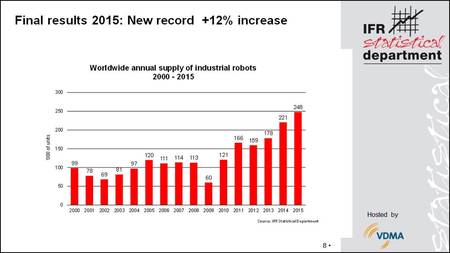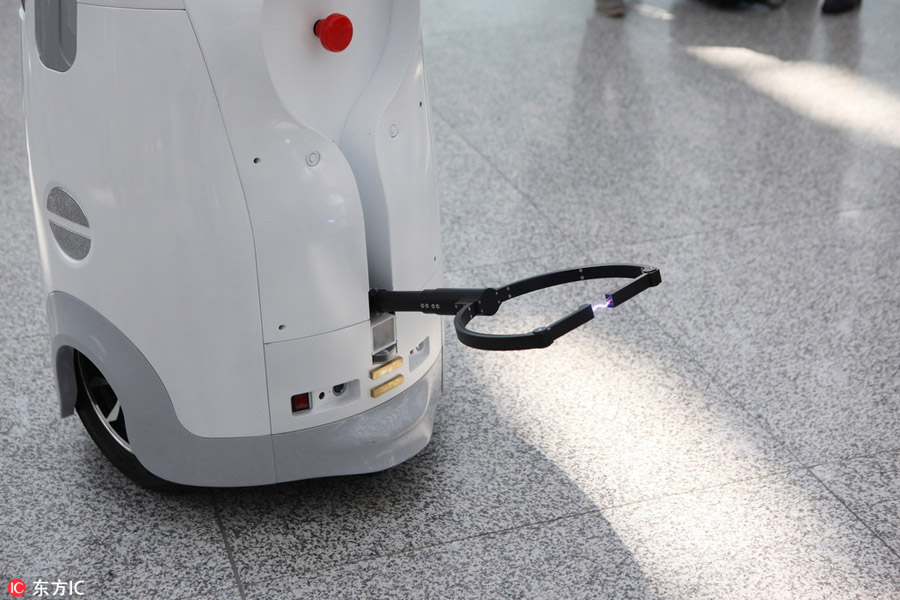While debate surrounds the threat of autonomous “killer robots,” the mechanized replacement of humans continues across the workforce.
The industrial robotics industry is logging record sales worldwide, and there appears to be no sign of a slowdown. As you can see in the graphic below, 2015 sales surged 12% over a previous record year to reach almost 1/4 million units.
 There are many factors driving this growth, which you can read about here; but one point worth noting is that the two leading countries are the US and China, with China leading the way.
There are many factors driving this growth, which you can read about here; but one point worth noting is that the two leading countries are the US and China, with China leading the way.
The nature of robotics is also changing, as new developments in artificial intelligence are giving robots an increasing range of potential uses. One key area, of course, is security. Robot security guards have already begun appearing at prisons, care facilities, and schools, in various locations around the world.
One U.S. robot company, Gamma 2 Robotics, has designed several models for mass production. Their latest – RAMSEE – can be seen in the video below. A true mass roll-out of this fully autonomous security guard could significantly impact the 1.5 million humans that are currently employed in some form of security patrol.
RAMSEE advertises the following capabilities:
- Is a physical presence that autonomously patrols without supervision
- Provides real-time data: intruders, motion, heat, fire, smoke, gases & more
- Is a human-machine interface that creates a powerful force multiplier
Significantly, Gamma 2 Robotics has partnered with Hexagon Safety & Infrastructure: “the global leader in public safety and security solutions.”
However, RAMSEE is missing one thing: weapons. For that, we have to travel to China, where they seem to have embraced police robots full throttle.
In late 2015, I covered an announcement from China’s Xinhua news agency where they announced the development and deployment of 3 weaponized “anti-terrorism” robots that would be far more active than a mere patrol:
“The toy-sized robots can coordinate with each other on the battlefield,” said the report, following their unveiling at the 2015 World Robot Conference in Beijing.
The first model is known as a “reconnaissance” robot, which scouts for poisonous gases, dangerous chemicals and explosives before transmitting its findings back to base.If this initial investigation detects a simple bomb is the source of danger, the second robot model – a small explosive ordnance disposal (EOD) machine – would be sent in to diffuse it.
But with other, more complicated threats, an attacker robot would start its mission, armed with “minor-caliber weapons, recoilless rifles and grenade launchers”.
“With a sighting telescope, a trigger and a safe installed, the attacker can hit its target from a long distance,” Xinhua said.
The local police force in Beijing was reported to be among the buyers for the three robots, which are priced at 1.5 million yuan (£156,000) for the set by manufacturers HIT Robot Group, who are based in the northern city of Harbin.
“Apart from anti-terror operations, they can also be applied in fire fighting, public security, forestry and agriculture,” the company’s sales manager Chen Deqiang said, according to Xinhua.
If we have learned anything about anti-terrorism efforts, authorities consider front-line deployment to be areas of public travel. We were given the TSA based on such notions, and have since witnessed its intrusive role in airports, and soon-to-be at other public transportation if authorities have their way.
China has gone to the next level with a robot TSA of sorts called AnBot that is equipped with what is essentially a taser-like device that is being fittingly compared to a cattle-prod.
It was first introduced at a tech show earlier in the year, and was speculated to have been designed for protest suppression. For now, its first job is to patrol China’s Shenzhen airport.
Most alarming, however, is that it is tied to one of the most powerful supercomputers on the planet.
The back end of this “intelligent security robot” is linked to China’s Tianhe-2 supercomputer, where it has access to cloud services. AnBot conducts patrols, recognizes threats and has multiple cameras that use facial recognition.
These cloud services give the robots petascale processing power, well beyond onboard processing capabilities in the robot. The supercomputer connection is there “to enhance the intelligent learning capabilities and human-machine interface of these devices,” said the U.S.-China Economic and Security Review, in a report released Tuesday that examines China’s autonomous systems development efforts. [emphasis added]
(Source)
 This link to “cloud services” is a new trend in robot artificial intelligence that also has been referred to as the Wikipedia for Robots – essentially an Internet Cloud Brain. Through robot-to-robot information sharing they can speed up their learning process … autonomously. Examples have included robots that can learn to cook, and robots that can learn the tasks involved in care-giving. However, when applied to policing, things become much more ethically troubling.
This link to “cloud services” is a new trend in robot artificial intelligence that also has been referred to as the Wikipedia for Robots – essentially an Internet Cloud Brain. Through robot-to-robot information sharing they can speed up their learning process … autonomously. Examples have included robots that can learn to cook, and robots that can learn the tasks involved in care-giving. However, when applied to policing, things become much more ethically troubling.
People were outraged in the U.S., for example, when a robot in Dallas was used to deliver a pound of C-4 explosive to a U.S. citizen whom the police deemed a sufficient threat worthy of immediate execution. At least, in that case, a human made the decision. But it is being viewed as a tip-toe along the path to the widespread use of “killer robots” much as we have seen with the use of drones. Discussion was once limited to overseas – egregious enough – but there has been a growing voice of those who are urging weaponized domestic police drones.
As John Vibes wrote, it might be inevitable:
The Taser corporation is planning on building a drone that is equipped with a stun gun, according to a recent report by the Wall Street Journal.
Not only will the drones be equipped with tasers, but there is also talk of them being autonomous, meaning that an actual human won’t necessarily be needed to fly the drone.
This is actually already being done in India, the first country to have approved the use of drones attached with “non-lethal” weapons. And, just this week, British tabloid, The Sun, had a feature entitled “Vladimir Putin’s Russia is preparing an army of robots and drones to take on its enemies, Deputy PM Dmitry Rogozin admits.” Given the available facts, this title no longer seems so deliberately sensational.
Clearly we are entering a potentially dangerous convergence of expanding robotic artificial intelligence along with the political will to continue allowing robots more and more autonomy as they carry out the traditional duties of the military and police. Some experts argue that the precision of robotics will curb many of the abuses we have seen from our military and police. But is that the trend we are actually seeing? Or will automated systems of violent control inevitably lead to even greater industrial-level suppression and killing?
Nicholas West writes for ActivistPost.com. This article may be republished in part or in full with author attribution and source link.


R2D2
It’s more like Wong Wobot
and of course none of these things will ever malfunction or be hacked…
Coming here soon They are for YOUR safety !
Almost all security personnel are also trained in life saving methods like CPR, unblocking a choking victims airway; calming a lost child – can the robots do any of that – NO.